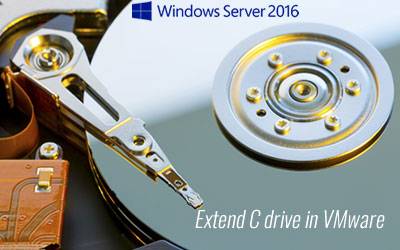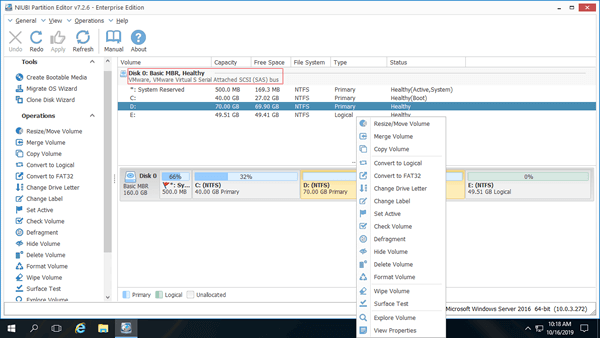Many Windows servers are running as virtual machine in VMware. There are many advantages to run virtual servers, but the same with physical server, C drive in virtual machine runs out of space, too. To solve this problem, you still need to extend C drive with free space in other virtual partition. This article introduces how to resize partition and extend C drive in VMware with Windows Server 2016/2019/2022.

Resize VMware partition in Windows Server without software
If you run Windows Server 2016/2019/2022 as virtual machine in VMware, there's no difference with physical server while resizing VMware virtual partition. To do this, there are 2 kind of tools - Windows native Disk Management or diskpart command and third party disk partition software.
Windows Disk Management has graphical interface, diskpart works via command prompt. Although they work in different way, they have same restrictions when shrinking and extending partition. Because of these restrictions, both native tools are not the best choice.
- How to shrink partition in Server 2016 Disk Management
- How to extend partition in Server 2016 Disk Management
- How to shrink partition with diskpart command
- How to extend partition with diskpart command
Third party software is much more powerful, but you'd better back up first and run safe software, otherwise, there's potential system damage and data loss risk. Better than other tools, NIUBI Partition Editor has innovative technologies to protect system and data.
- Virtual Mode - all operations will be listed as pending for preview, real disk partitions won't be changed until click "Apply" to confirm.
- Cancel-at-will - if you applied incorrect operations, you can cancel the ongoing operations without damaging partitions.
- 1-Second Rollback - if any error is detected while resizing partitions, it automatically reverts server to original status in a flash.
- Hot Clone - clone disk partition without server interruption, you may clone system disk before any operation or regularly as backup.
To resize virtual partition in VMware with Server 2016/2019/2022, you just need to install NIUBI in VMware, then drag and drop on the disk map.
Extend C drive in VMware Server 2016/2019/2022 with safe tool
Download NIUBI Partition Editor, you'll see all disks with graphical partition structure on the right side. Available operations to the selected disk or partition are listed on the left and by right clicking.
In physical server, NIUBI will show every disk with real model. In VMware virtual machine, all disks are shown as VMware Virtual.
To extend system partition C in VMware, firstly, check if there's enough free space in the contiguous partition D. If yes, shrink it to get unallocated space, and then add into C drive. If there's not plenty of free space in drive D, you can shrink E or any other non-adjacent partition on the same virtual disk. In that case, there's an additional step to move unallocated space to the left before adding into C drive.
Steps to extend C drive in VMware Windows Server 2016/2019/2022:
- Right click drive D: and select "Resize/Move Volume", in the pop-up window, drag left border towards right or enter an amount directly in the box of "Unallocated space before".
- Right click C: drive and select "Resize/Move Volume" again, drag right border towards right to combine this contiguous unallocated space.
- Click Apply on top left to execute, done.
Disk partitions won't be changed until click Apply to confirm, before this step, you can click Undo to cancel any unwanted pending operations.
How to extend VMware partition when virtual disk is full
In physical server, if there's no available free space on the same disk, no software can add space from another separate disk. You have to clone disk to a larger one and expand system partition (and other volumes) with extra disk space. But in VMware, it is much easier.
- Follow the step to expand virtual disk in VMware, then additional space will be shown as unallocated at the end of original virtual disk.
- Follow the steps in the video to merge unallocated space to C drive (and other partitions).
In Summary
To resize partition and extend C: drive in VMware running Windows Server 2016/2019/2022, there's no difference when there's available free space on the same virtual disk. If there's not enough free space in all other data volumes on the same disk, you can expand VMware virtual disk and then extend C drive with extra unallocated space. Besides shrinking, moving and extending partition in Server 2016/2019/2022 and previous Server 2003/2008/2012, NIUBI Partition Editor helps you do many other disk partition management operations.


